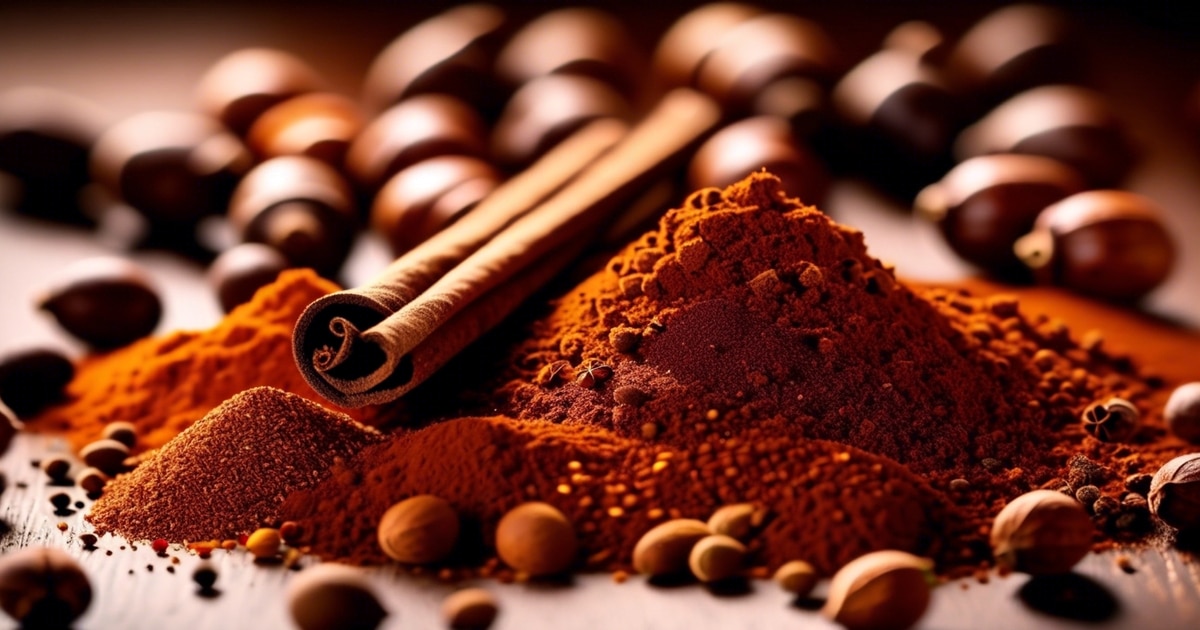Key Takeaways
-
Making your allspice blend allows you to control the flavor and quality, ensuring a personalized touch to your dishes.
-
Store your homemade allspice in an airtight container away from heat and sunlight to maintain freshness and flavor.
-
Experiment with creating allspice substitutes using common kitchen spices like cinnamon, cloves, and nutmeg for recipes that require allspice.
-
Get creative with allspice by incorporating it into sweet and savory dishes, such as baked goods, marinades, and stews.
-
Allspice adds a warm, earthy flavor to dishes and can be used in various recipes, from desserts to meat dishes.
-
Enhance your culinary creations by exploring the versatility of allspice in different cuisines and cooking styles.
We’re excited to talk about making allspice at home with you. We’ll cover its history and how it can be used in cooking. We’ll also guide you on making allspice at home, including what you need and how to do it. Plus, we’ll share some tasty recipes using homemade allspice.
Understanding Allspice and Its Unique Flavor
Distinctive Taste
Its unique flavor profile sets it apart. We’ve learned it’s not a blend but a single spice, offering hints of cloves, cinnamon, and nutmeg. This means that when we use homemade allspice in our recipes, we incorporate the essence of multiple spices into one.
Allspice truly lives up to its name by embodying the flavors of several different spices simultaneously. Imagine the convenience of having such a versatile spice in your pantry! Derived from the dried unripe berries of the Pimenta dioica plant, homemade allspice brings an unparalleled depth of taste to our culinary creations.
Culinary Applications
We’ve discovered that this exceptional spice can be used in sweet and savory dishes. In baking, adding a pinch or two of homemade allspice to apple pies or pumpkin bread can elevate their flavors with warm notes reminiscent of autumnal spices. On the savory side, incorporating it into marinades for meats or sprinkling it over roasted vegetables adds complexity and richness to our favorite meals.
Ingredients Needed for a Perfect Allspice Blend

Primary Ingredients
Creating homemade allspice requires specific ingredients to achieve the perfect blend. The primary components include whole cloves, cinnamon sticks, and whole nutmeg. These foundational elements form the base of the allspice mixture, providing its distinct flavor profile.
Combining these three ingredients is crucial in capturing the essence of allspice. For instance, whole cloves contribute a warm, pungent flavor with hints of sweetness and bitterness. Similarly, cinnamon sticks bring unique sweet and woody notes to the blend, enhancing its overall aroma and taste. Lastly, whole nutmeg adds a subtle sweetness and a slightly nutty undertone to round out the flavors.
Additional Essentials
In addition to the primary ingredients, ground ginger, ground mace, and ground bay leaves are essential components that complement and enrich the homemade allspice blend. Ground ginger introduces a spicy warmth, while ground mace contributes a delicate citrusy note. Furthermore, ground bay leaves add an earthy element to balance the flavor profile.
When combined in precise measurements, these additional essentials work harmoniously with the primary ingredients to create an aromatic allspice blend that captures warmth and complexity.
Step-by-Step Guide to Making Your Own Allspice
Toasting the Spices
We start by toasting the whole spices to bring out their flavors. This step is crucial as it enhances the aroma and taste of the allspice blend. We can toast a combination of cloves, cinnamon sticks, and peppercorns in a dry skillet over medium heat for a few minutes until they become fragrant. This process intensifies their natural oils, making our homemade allspice more aromatic.
After toasting, we allow the spices to cool before grinding them into a fine powder. It’s important not to rush this step because hot spices can create excess moisture when ground, leading to clumping or uneven texture in our final product.
Measuring and Grinding
Once cooled, we carefully measure each toasted spice according to our recipe’s precise quantities. Accurate measurements are essential for achieving the perfect balance of flavors in our homemade allspice blend. Whether it’s cloves, cinnamon sticks, or peppercorns – every ingredient plays a vital role in creating that signature allspice taste.
Next comes the grinding process. We use a spice grinder or mortar and pestle to achieve a uniform texture for our allspice blend. The goal is to grind the toasted spices into a fine powder while ensuring no large pieces remain. A consistent texture guarantees an even distribution of flavors throughout our homemade allspice mixture.
Storing Your Homemade Allspice for Freshness
Airtight Container
We always use an airtight container. This helps keep the allspice fresh by preventing air from getting in and affecting flavor. We make sure the lid is tightly sealed to maintain its potency.
We also place the container in our pantry’s cool, dark area. This ensures that our homemade allspice is shielded from direct sunlight and heat, which can degrade its quality over time.
Labeling and Small Batches
Labeling the container with the date of preparation is crucial for us. It allows us to track how long our homemade allspice has been stored, helping us know when to make a fresh batch. Doing this ensures we use the freshest blend possible in our recipes.
We’ve found that making small batches at a time works best for maintaining the optimal flavor profile of our homemade allspice. This approach ensures that we always have a fresh supply without going to waste.
Crafting the Ideal Allspice Substitute from Scratch
Customizing the Blend
When creating a homemade allspice substitute, we can combine equal parts of cinnamon, cloves, and nutmeg. This blend provides a similar flavor profile to allspice. By adjusting the proportions of these spices, we can tailor the taste to our liking. For instance, if we prefer a more pronounced nutmeg flavor, we can increase its quantity.
We might also want to experiment with additional spices to create a unique substitute blend. For example, adding some ginger or mace could introduce new layers of flavor to our homemade allspice. The beauty of crafting our spice blends is that it allows us to customize and tailor flavors according to our preferences and culinary creations.
Exploring Endless Possibilities
The versatility of creating a homemade allspice alternative opens up endless possibilities for enhancing various dishes. Whether it’s spicing up baked goods like apple pie or infusing warmth into savory stews and marinades, this personalized blend adds depth and complexity to our culinary endeavors.
Creative Variations to Traditional Allspice Recipes
Sweet Recipes
We love infusing homemade allspice into sweet treats like apple pie or spiced cakes. It adds a warm and aromatic twist, elevating the flavors of these classic desserts. For example, adding a hint of homemade allspice to an apple pie filling creates a delightful depth of flavor that complements the sweetness of the apples.
Incorporating homemade allspice into baked goods like muffins or cookies can also bring out rich, cozy flavors perfect for fall and winter. The warmth and complexity it brings make these treats even more comforting and satisfying.
Savory Dishes
Using homemade allspice in marinades or rubs for meats is our go-to technique. It adds depth and complexity to the flavor profile, making each bite a flavorful experience. For instance, marinating chicken with a blend that includes homemade allspice results in juicy, flavorful meat with layers of deliciousness.
Another way we enjoy incorporating homemade allspice into savory recipes is by adding it to soups or stews. Its warm notes complement hearty ingredients like root vegetables and beans wonderfully.
Beverages
Exploring different ways to use homemade allspice in beverages has been an exciting journey for us. Mulled cider infused with homemade allspice offers a comforting winter flavor that warms both body and soul on chilly evenings. Adding a pinch of this versatile spice to hot toddies creates an inviting depth of flavor that makes them even more enjoyable during cold weather.
Serving Suggestions for Allspice-Infused Dishes

Versatile Pairings
When serving homemade allspice-infused dishes, we love to pair them with various sides to enhance the dining experience. For savory dishes like jerk chicken or stewed meats, we recommend serving them with roasted vegetables such as carrots, sweet potatoes, or butternut squash. The allspice’s warm and earthy notes beautifully complement the caramelized flavors of the roasted vegetables.
For heartier meals, consider pairing your allspice-infused creations with rice pilaf. The aromatic blend of rice cooked with spices and broth perfectly complements the robust flavor profile imparted by the allspice. This combination creates a harmonious balance that elevates each component of the dish.
Elevating Flavors
Try incorporating allspice into sauces or dressings to further elevate your culinary creations. Whether it’s a tangy barbecue sauce for grilled meats or a zesty vinaigrette for salads, adding a hint of allspice can bring depth and warmth to your homemade condiments. Adding this versatile spice enhances the overall flavor profile of your dish, leaving your taste buds pleasantly surprised.
Incorporating allspice in sweet and savory applications allows us to explore its full potential in our cooking endeavors. From spiced apple pies and cakes to Jamaican meat patties and Middle Eastern kebabs, allspice adds an intriguing layer of flavor that transcends culinary boundaries.
Exploring the Versatility of Allspice in Various Recipes
Unexpected Twists
When experimenting with homemade allspice, we found that adding it to traditional recipes like chili, stews, or even chocolate desserts can bring an unexpected twist. For instance, a pinch of allspice in a rich chocolate brownie recipe adds depth and warmth to the flavor profile. It’s amazing how this simple addition can elevate familiar dishes.
Using allspice in different kinds of food worldwide makes the flavors more interesting. For example, in Jamaican jerk seasoning, allspice, cinnamon, and nutmeg give the dish a special taste. Using allspice in Middle Eastern rice dishes or Scandinavian baked goods helps us try new flavors and learn more about different foods.
Cultural Adaptations
Our exploration led us to discover new ways of using allspice by exploring different cultural culinary traditions and adapting them into our recipes. We learned that this versatile spice is widely used across various cuisines worldwide, from the Caribbean to the Middle East and beyond. By taking inspiration from these diverse cooking styles, we’ve been able to infuse our everyday meals with unique and delightful flavors.
Final Remarks
We learned about allspice and how it tastes, made our mixes, and tried it in different recipes. Now we can use allspice to make our food taste even better. Let’s use what we know to try new things with allspice, tell our friends and family about it, and keep having fun cooking. We love being creative in the kitchen and enjoy trying new things and making delicious flavors.
Frequently Asked Questions
What is allspice, and what does it taste like?
Allspice is a dried berry from the Pimenta dioica plant, native to Central America. It has a complex flavor profile that combines hints of cinnamon, nutmeg, and cloves with a peppery undertone.
Can I make my own allspice blend at home?
You can easily make your allspice blend by combining equal parts of ground cinnamon, cloves, and nutmeg. This allows you to adjust the proportions to suit your taste preferences.
How should I store homemade allspice for freshness?
Store homemade allspice in an airtight container away from direct sunlight or heat sources to maintain its freshness and flavor potency. A cool, dark pantry or cupboard is ideal for preserving its quality.
Are there any suitable substitutes for allspice if I don’t have it on hand?
You can create a simple substitute by combining equal parts of ground cinnamon, cloves, and nutmeg. Alternatively, using a small amount of each spice can also mimic the flavor profile of allspice in recipes.
What are some creative variations for using homemade allspice in recipes?
Homemade allspice can be used in various recipes, such as marinades for meats or vegetables, baking (in cakes or cookies), and pickling spices for fruits or vegetables like apples or cucumbers.

